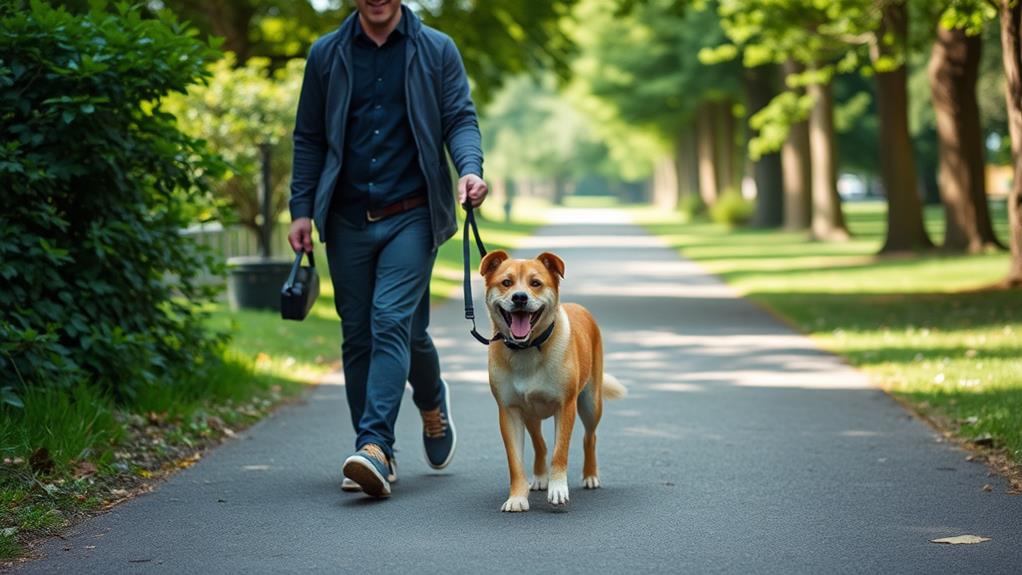Seamless leash walking can turn your daily walks into enjoyable adventures. Start by understanding your dog's behavior and energy levels. Choose a suitable leash—6-foot nylon works well for most dogs. Use positive reinforcement; reward them for walking nicely beside you. Practice loose leash walking in quiet areas to minimize distractions. Establish a consistent routine for walks to reinforce good behavior regularly. Manage distractions effectively, using high-value treats to keep their focus. Finally, be patient and persistent; training takes time. Stick with it, and discover how these tips can make a real difference in your walks together.
Understand Your Dog's Behavior
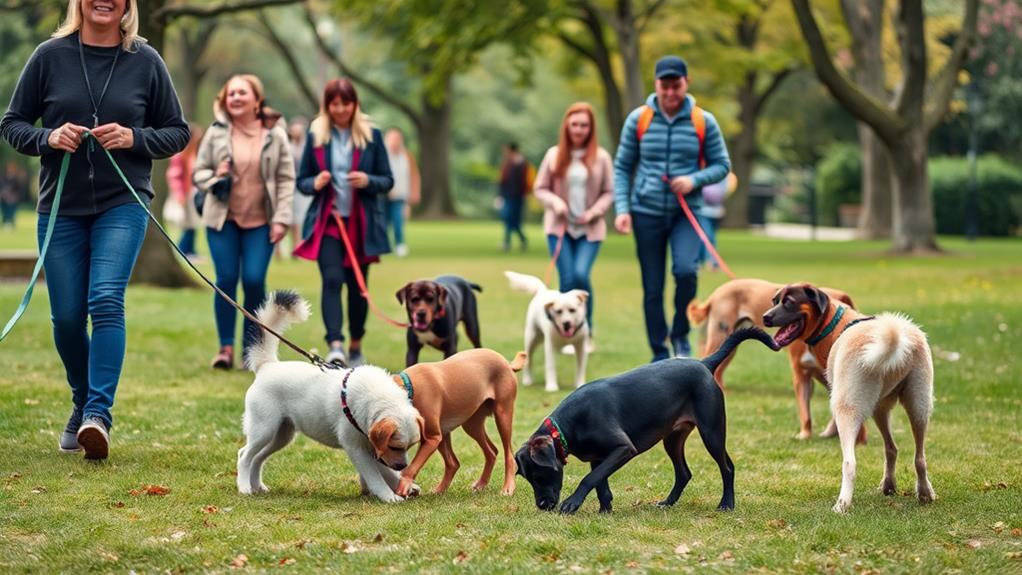
Understanding your dog's behavior is essential for effective training. When you grasp why your dog acts a certain way, you can tailor your approach to meet their needs. Dogs communicate through body language, vocalizations, and actions, so pay close attention to these signals. For instance, a wagging tail doesn't always mean happiness; it can indicate excitement or even agitation.
Recognizing signs of stress, like panting or retreating, is pivotal too. If your dog seems anxious, it may be time to adjust your training methods or environment.
Also, consider their energy levels. A high-energy dog might need more exercise before training sessions to stay focused and engaged.
When you understand what motivates your dog, you can use that to reinforce positive behaviors. Whether it's praise, treats, or playtime, find out what excites them and use it to your advantage.
Lastly, remember that every dog is unique. What works for one may not work for another. Take the time to observe and learn about your furry companion, and you'll create a more effective training experience that strengthens your bond.
Choose the Right Leash
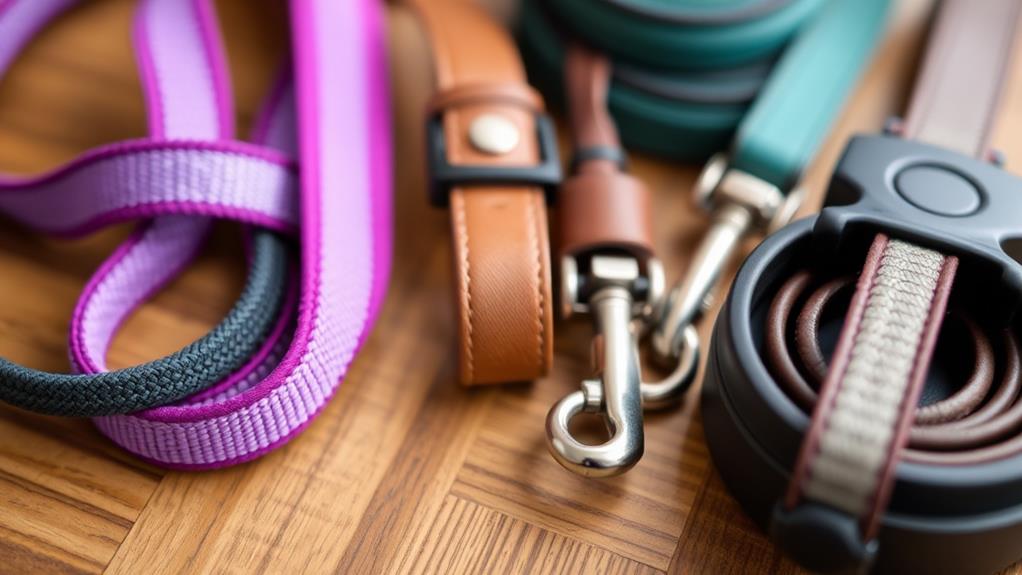
Choosing the right leash is essential for effective dog training and guarantees both safety and control during walks. You've got several options, and each serves a different purpose. For everyday walks, a standard 6-foot leash made of nylon or leather is usually best. It gives you enough length to allow your dog some freedom while still keeping them close.
If you're training a larger or more energetic dog, consider using a sturdy leash with a padded handle for added comfort. You might also explore retractable leashes, but use them with caution. They can give your dog more freedom, but they also risk losing control if your dog suddenly bolts.
For specific training needs, a training leash or a long line can help you teach your dog recall or other commands. Just make sure it's durable enough to withstand your dog's strength. Remember, the collar or harness you choose also plays a vital role; it should match your leash in terms of safety and regulation.
Ultimately, the right leash not only enhances your training efforts but also makes walks more enjoyable for both you and your dog. Choose wisely to set the stage for success!
Use Positive Reinforcement
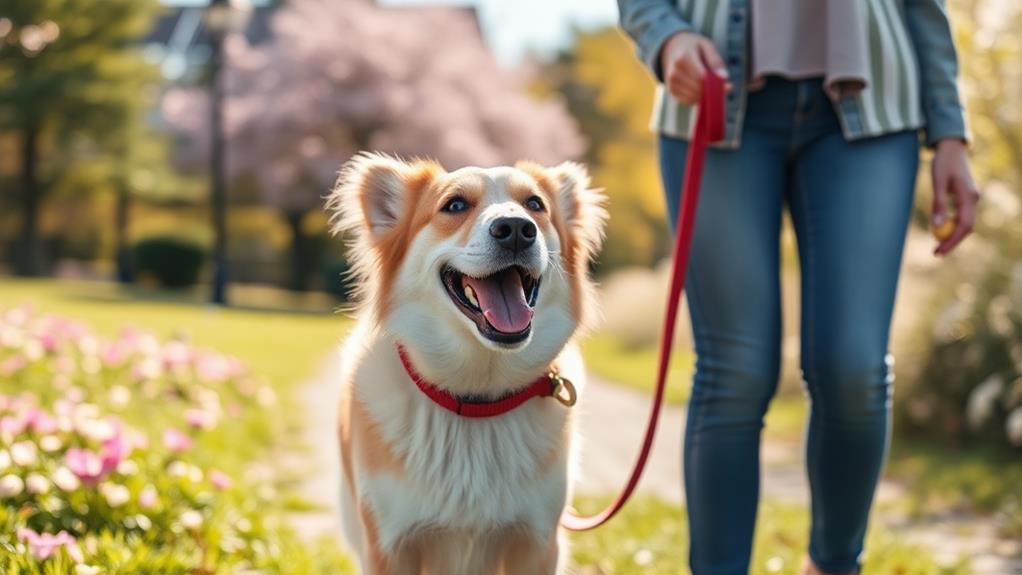
Positive reinforcement is one of the most effective methods for training your dog, as it builds a strong bond between you and your furry friend. By rewarding your dog for good behavior, you encourage them to repeat those actions. For leash walking, this means rewarding your dog when they walk calmly beside you, rather than pulling on the leash.
Use treats, praise, or playtime as rewards. When your dog displays the desired behavior, immediately offer a treat or verbal praise like "Good boy!" or "Good girl!" This helps them associate the action with positive outcomes. Timing is paramount; if you wait too long to reward, your dog may not connect the reward with their behavior.
Consistency is key. Make sure everyone involved in walking your dog uses the same commands and rewards. This helps reinforce the behavior and prevents confusion. Gradually decrease treats as your dog improves, but continue to offer praise to maintain their motivation.
Practice Loose Leash Walking
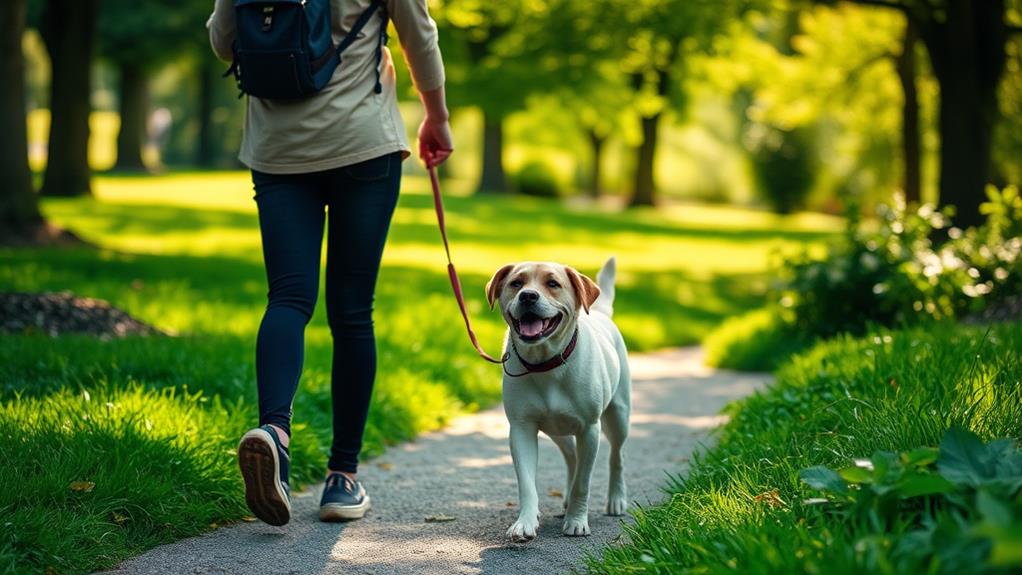
Practicing loose leash walking is essential for enjoyable and stress-free walks with your dog. When your pup learns to walk calmly beside you, both of you can experience the great outdoors without the tug-of-war struggle. Start by choosing a comfortable collar or harness, and guarantee your dog is familiar with the equipment. Use treats as motivation, rewarding your dog when they maintain a loose leash.
Start Slow: Begin in a quiet area to minimize distractions and gradually increase the difficulty.
Use Short Sessions: Keep training sessions brief to maintain your dog's focus and enthusiasm.
Change Directions: If your dog pulls ahead, change direction suddenly to encourage them to pay attention to you.
Reward Frequently: Offer treats and praise regularly when your dog walks beside you without pulling.
Stay Patient: Remember that consistency is key, and every dog learns at their own pace.
With practice and positive reinforcement, you'll both enjoy more pleasant walks together. Embrace the journey, and celebrate the small victories along the way!
Establish a Consistent Routine
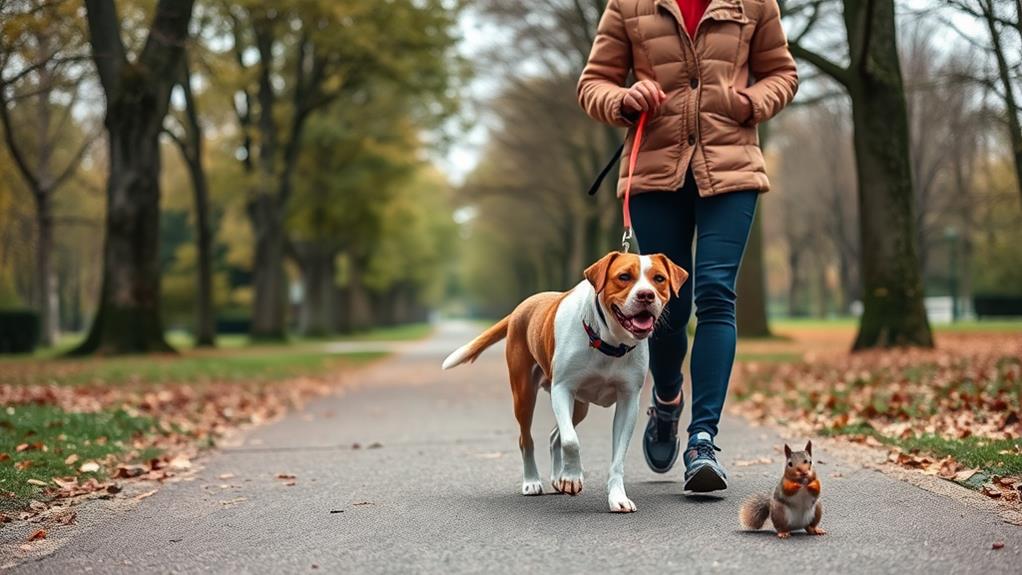
Establishing a consistent routine is essential for your dog's training and overall well-being. Dogs thrive on predictability, and a regular schedule helps them understand what to expect throughout the day. Start by setting specific times for walks, meals, and play. This not only reinforces good behavior but also builds trust between you and your dog.
When you consistently walk your dog at the same time each day, they'll learn to associate those moments with exercise and exploration. Make sure to include leash training in your routine. If you practice loose leash walking during these outings, your dog will become accustomed to walking calmly by your side.
In addition, consistency in commands is indispensable. Use the same words and tone for commands every time. This repetition helps your dog grasp what you want from them, making training more effective.
Also, consider incorporating short training sessions into your daily routine. These can be just a few minutes long but can make a significant impact on your dog's obedience. By establishing a routine, you're not just training your dog; you're also creating a happier, more balanced companion.
Manage Distractions Effectively
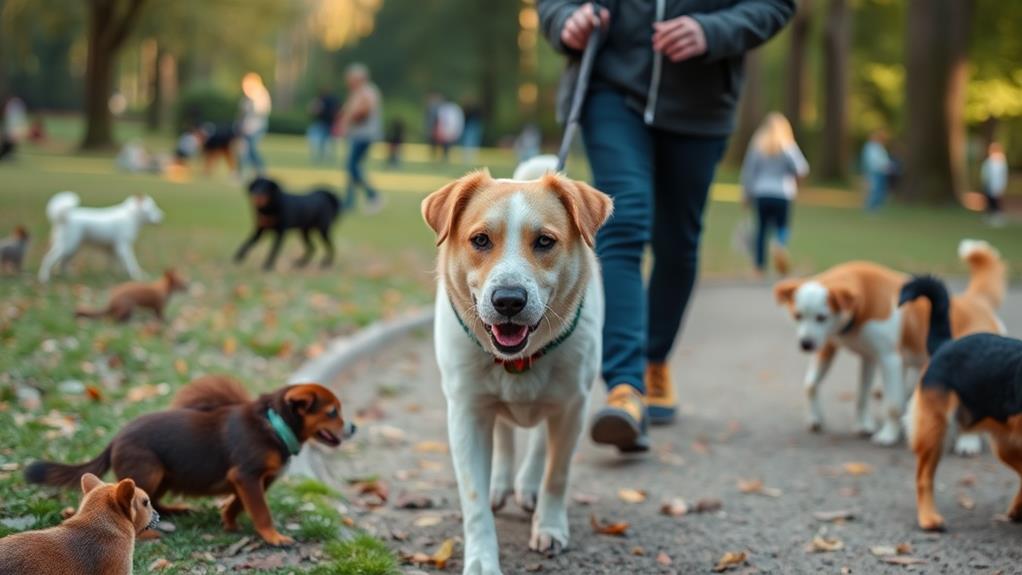
Managing distractions effectively is essential for successful dog training, especially in busy environments. When you're out walking your dog, it's common for distractions to pop up, from other dogs to loud noises. By anticipating these distractions, you can better prepare your dog to stay focused.
Some strategies to help you manage distractions:
- Choose Training Locations Wisely: Start in quieter areas before progressing to busier streets.
- Use High-Value Treats: Keep your dog motivated by offering treats they love when distractions arise.
- Practice Commands: Reinforce basic commands like "sit" and "stay" in varying environments to improve focus.
- Gradual Exposure: Slowly introduce your dog to distractions, rewarding them for remaining calm and attentive.
- Stay Calm Yourself: Your energy influences your dog; staying composed helps your dog feel secure.
Be Patient and Persistent
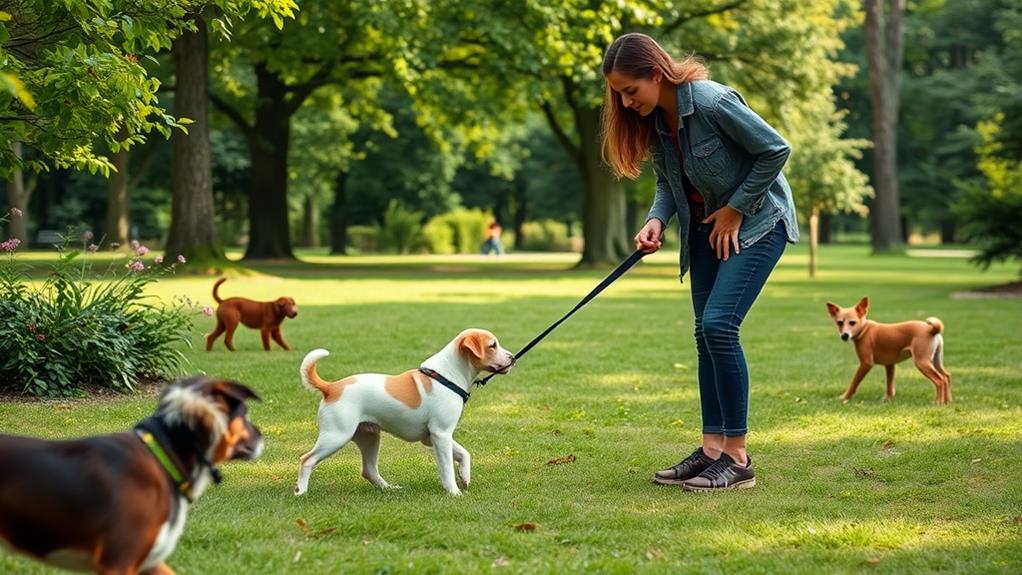
Even with effective distraction management, it's important to remember that training takes time. Your dog won't master leash walking overnight, and that's perfectly okay. Patience is key. When you encounter setbacks—like pulling, lunging, or getting distracted—don't get frustrated. Instead, take a deep breath and refocus on your training goals.
Persistent practice is indispensable. Set aside dedicated time each day to work on leash walking, even if it's just for a few minutes. Consistency helps reinforce the behaviors you want to see. If your dog isn't getting it right away, try different techniques or adjust your approach. Sometimes, changing your location or time of day can make a big difference.
Celebrate small victories, too. If your dog walks calmly for even a short distance, give them praise or a treat. This positive reinforcement builds their confidence and encourages them to repeat the desired behavior.
Frequently Asked Questions
What Age Should I Start Leash Training My Puppy?
You should start leash training your puppy as soon as you bring them home, typically around eight weeks old. Early training helps establish good habits and makes walks enjoyable for both you and your furry friend.
Can I Use a Harness Instead of a Collar?
Using a harness instead of a collar can reduce strain on your dog's neck by up to 75%. It's a great choice, especially for puppies, since it provides better control and comfort during walks.
How Do I Handle Pulling During Walks?
When your dog pulls during walks, stop moving. Wait for them to relax, then reward them for staying by your side. Consistently practice this, and you'll teach them to walk calmly beside you.
What Should I Do if My Dog Is Afraid of Leashes?
If your dog fears leashes, it is crucial to balance patience with persistence. Start by introducing the leash gradually, rewarding calm behavior. Consistent, positive experiences will transform their anxiety into confidence, making walks enjoyable for both of you.
How Long Should Each Training Session Last?
Each training session should last about 5 to 15 minutes. Keep it short and engaging, so your dog stays focused and keen to learn. You'll see better results with consistent, manageable sessions.
Conclusion
By implementing these essential tips, you'll transform leash walking with your dog into a harmonious experience, much like a well-rehearsed dance. Remember, understanding your dog's behavior and using positive reinforcement are key to building a strong bond. Stay consistent, manage distractions, and most importantly, be patient. With time and persistence, you'll both enjoy your walks, forging a connection that makes every outing a joy rather than a chore. Happy walking!

